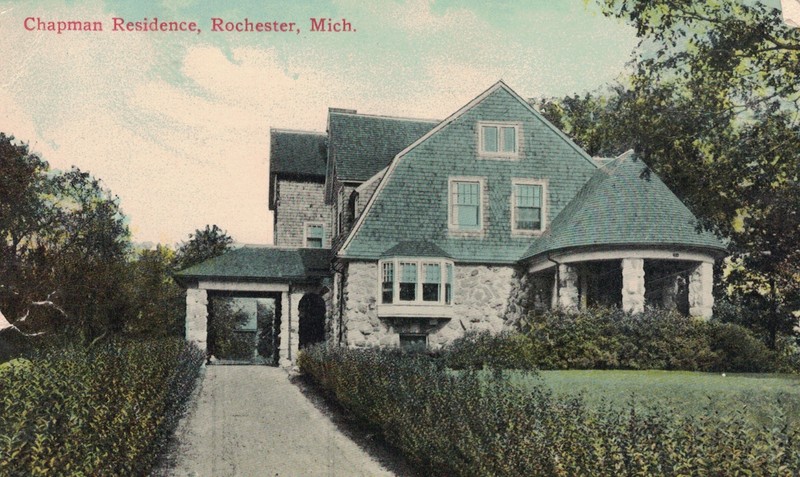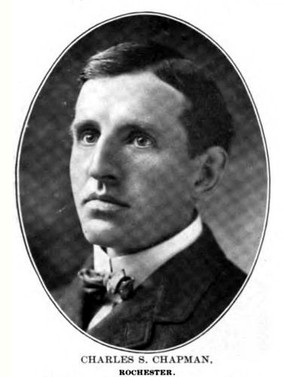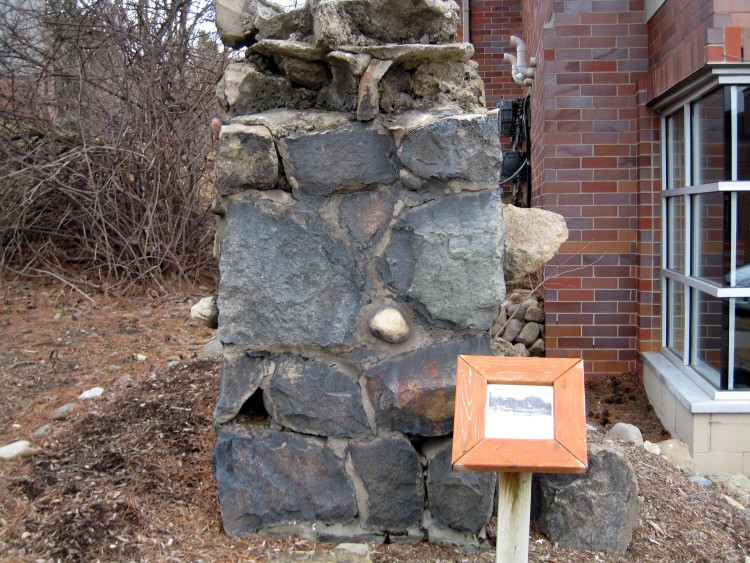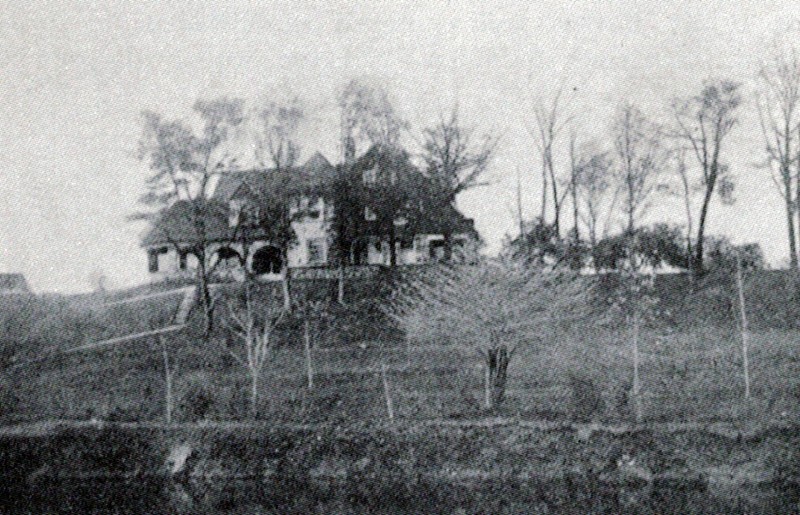Charles Sherwin Chapman Estate Historical Marker
Introduction
Text-to-speech Audio
Images
Postcard view of Charles Sherwin Chapman Estate, ca. 1915

Charles Sherwin Chapman, ca. 1904

Surviving pillar from Charles S. Chapman estate, with historical marker

Close-up of historical marker on surviving stone pillar from Charles S. Chapman estate

Charles Sherwin Chapman Estate, ca. 1907

Backstory and Context
Text-to-speech Audio
This property was the prior location of the Charles Sherwin and Minerva Robbins Chapman estate, known as Oak Bluff. The house was built in 1899 and demolished in 1968. On April 28, 1899, the Rochester Era reported that “ground was broken last Monday for C.S. Chapman's new residence on the bluff north of the village.” The Detroit Free Press reported as follows on August 27 of the same year:
[begin quote]
Architects Nettleton & Kahn have prepared plans for a fine residence for C. L. [sic] Chapman, owner of the Western Knitting mills at Rochester, an illustration of which is given herewith. It will occupy a beautiful location at the summit of a hill, overlooking the town and will be the finest residence in the locality. The lower portion will be constructed of field stone; the upper part being of frame; the sides, gables and roof to be covered with stained shingles. The interior finish will be of choice hard woods and the house will be equipped with modern conveniences.
[end quote]
At the time that the Chapman house was designed, Albert Kahn was in partnership with George Nettleton in the firm of Nettleton & Kahn. Nettleton died in 1900.
The house, overlooking Paint Creek on the east side of North Main Street, was one of the few residential designs created by famed industrial architect Albert Kahn. Chapman named the estate “Oak Bluff” for its obvious natural attributes and enjoyed the fact that he could commute from his home to his office at the Western Knitting Mills by taking a small motorboat across the mill pond that stretched between the two locations. Features of the house included a hand-carved staircase and fireplace mantels, a music room, and a billiard room on the third floor. Cost of construction in 1899 was estimated at $20,000.00.
After the deaths of the senior Chapmans, the house passed to the ownership of Frank Chapman (1901-1977) and his sister Doris Chapman Blackwood (1896-1989). Neither Frank nor Doris Chapman chose to live in their childhood home after the death of their mother in 1951. They leased the house for use as the Stoney Croft rest home, a nursing home for women. That arrangement ended after authorities determined that the house lacked sufficient stairways and other safety features for use as a residence for the infirm. After Stoney Croft moved out, the house was closed up, but was often visited by squatters and vandals. Concerned about liability, the Chapman family placed the property on the market and sold it for redevelopment. The house was razed on February 13, 1968, and an apartment complex was built on the site.
One lone pillar from the stone fence that had marked the west perimeter of the estate property remained standing after the land was redeveloped. Located on the property line with St. Philip's Episcopal Church, the pillar was identified with an interpretive sign by an Eagle Scout.
Sources
'Buildings in the State," Detroit Free Press, August 27, 1899, p.6.
"Ground was broken last Monday for C.S. Chapman's new residence on the bluff north of the village," Rochester Era, April 28, 1899.
"Work on C.S. Chapman's stone house on the bluff overlooking Rochester from the east is progressing and up to the second story...," Rochester Era, August 4, 1899.
"Chokes to Death: Prominent Rochester Banker Dies at Pontiac; Charles S. Chapman Had Extensive Business Connections in Detroit, Wisconsin and at Home," Flint Journal, May 6,1912, p.3.
"The Late C.S. Chapman," Rochester Era, May 10, 1912, p.1.
"United States Census, 1900," database with images, FamilySearch (https://familysearch.org/ark:/61903/1:1:MS9K-DBR : accessed 19 January 2018), Chas S Chapman, Avon township Rochester village, Oakland, Michigan, United States; citing enumeration district (ED) 81, sheet 13B, family 307, NARA microfilm publication T623 (Washington, D.C.: National Archives and Records Administration, 1972.); FHL microfilm 1,240,735.
"United States Census, 1910," database with images, FamilySearch (https://familysearch.org/ark:/61903/1:1:MLRV-Z64 : accessed 19 January 2018), Charles S Chapman, Avon, Oakland, Michigan, United States; citing enumeration district (ED) ED 117, sheet 6A, family 137, NARA microfilm publication T624 (Washington D.C.: National Archives and Records Administration, 1982), roll 668; FHL microfilm 1,374,681.
"United States Census, 1930," database with images, FamilySearch (https://familysearch.org/ark:/61903/1:1:XQ1V-3Z1 : accessed 19 January 2018), James A Blackwood, Rochester, Oakland, Michigan, United States; citing enumeration district (ED) ED 3, sheet 11A, line 49, family 283, NARA microfilm publication T626 (Washington D.C.: National Archives and Records Administration, 2002), roll 1016; FHL microfilm 2,340,751.
"A lesson can be learned [editorial on razing of the Chapman house]," Rochester Clarion, February 22, 1968.
Michigan art company. Men of Michigan. Detroit, Mich.: Michigan art company, 1904, p.351.
Men of Michigan. Detroit, Mich.: Michigan art company, 1904, p.351.
Deborah Larsen
Deborah Larsen
Fox, W.A. Beautiful Rochester: A Sketch of One of the Best Towns on the Map. W.A. Fox, 1907 [public domain]
